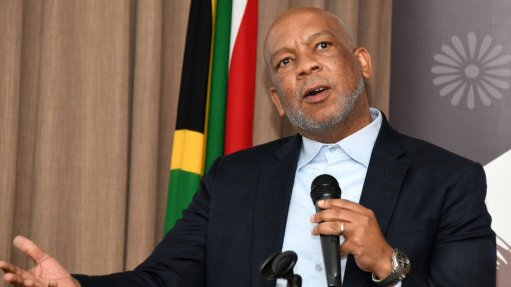Kinross widens Q3 loss as margins tumble
TORONTO (miningweekly.com) – Canadian miner Kinross Gold has widened its net loss for the three months ended September 30, as lower prices and higher costs chipped 20% off its profit.
The TSX- and NYSE-listed miner, which owned mines and projects in the US, Brazil, Russia, Mauritania, Chile and Ghana, reported a net loss of $52.7-million, or $0.05 a share, compared with a net loss of $4.3-million, or nil per share, in the comparable period a year earlier.
The loss was mainly attributable to lower margins as a result of a lower average gold price.
Excluding special items, Kinross reported an adjusted net loss of $23.9-million, or $0.02 a share, compared with adjusted net earnings of $70.1-million, or $0.06 a share, in the third quarter of 2014.
Revenue fell 14% year-on-year to $809.4-million, owing to a lower average realised gold price and lower gold-equivalent ounces (GEOs) sold. The average realised gold price declined 12% to $1 122/oz, compared with $1 268/oz in the third quarter of 2014.
Kinross’s attributable margin per GEO sold was $454, compared with $570 per GEO sold a year earlier.
Kinross produced 680 679 attributable GEOs in the third quarter, a slight decrease compared with the third quarter last year, mainly owing to lower output at Maricunga mine, in Chile, as a result of heavy rains in March, which impacted the tonnes of ore placed on the heap leach pads, and at Chirano mine, in Ghana, and Kettle River-Buckhorn mine, in Washington, owing to expected declines in grades.
The decrease was partially offset by higher output at Fort Knox, in Alaska, and the combined Kupol-Dvoinoye operation, in Russia, owing to higher mill grades, and at Round Mountain, in Nevada, owing to an improved heap leach performance and higher mill recoveries.
All-in sustaining costs (AISC) per GEO sold was $941 in the third quarter, compared with $919/oz a year earlier, mainly owing to higher capital expenditures and fewer attributable gold ounces sold, partially offset by lower energy costs and favourable foreign exchange rates.
As of September 30, Kinross had cash and cash equivalents of $1.02-billion, excluding restricted cash, an increase of $41.3-million since December 31, 2014. The company had available credit of $1.51-billion.
In the quarter, Kinross repaid the remaining $50-million balance on the Kupol loan and as of quarter-end, Kinross’s net debt was $949.2-million, a reduction of $11-million during the quarter and $84.1-million since the end of last year.
Other than $250-million in senior notes, which were scheduled to be repaid by September 2016, Kinross had no debt maturities until 2019.
MULLING MAURITANIA PLANS
Following the deferral of a previously studied 38 000 t/d mill expansion in the first quarter, Kinross had continued to explore practical alternatives to realising value at its Tasiast mine, in Mauritania, in the current gold price environment.
Kinross advised that it was completing early-stage engineering work on a potential two-phased expansion that would add incremental grinding capacity to Tasiast’s existing crushing circuit. A feasibility study of the initial Phase 1 expansion, which would increase mill throughput capacity from the current 8 000 t/d to 12 000 t/d, was expected to be completed in the first quarter of 2016. Phase 2 could further increase throughput capacity to as high as 38 000 t/d.
The company had acquired the Tasiast mine through a $7.1-billion acquisition of Red Back Mining in 2010, but the mine had failed to live up to expectations and the gold price meltdown over the last few years had prompted Kinross to book more than $6-billion in write-downs on the project.
As part of the company’s cost reduction efforts, Kinross had reduced its corporate headcount costs by 23% and was closing its Denver office. It had also laid off 222 Tasiast employees in September, for combined savings of about $30-million this year.
Kinross expected to be within the full-year guidance range of 2.5-million to 2.6-million GEOs, at an AISC of between $975 to $1 025 per GEO.
Kinross’s NYSE-listed stock had lost 37% in value since the start of the year, and on Tuesday closed 3.3% lower at $1.77 apiece.
Comments
Press Office
Announcements
What's On
Subscribe to improve your user experience...
Option 1 (equivalent of R125 a month):
Receive a weekly copy of Creamer Media's Engineering News & Mining Weekly magazine
(print copy for those in South Africa and e-magazine for those outside of South Africa)
Receive daily email newsletters
Access to full search results
Access archive of magazine back copies
Access to Projects in Progress
Access to ONE Research Report of your choice in PDF format
Option 2 (equivalent of R375 a month):
All benefits from Option 1
PLUS
Access to Creamer Media's Research Channel Africa for ALL Research Reports, in PDF format, on various industrial and mining sectors
including Electricity; Water; Energy Transition; Hydrogen; Roads, Rail and Ports; Coal; Gold; Platinum; Battery Metals; etc.
Already a subscriber?
Forgotten your password?
Receive weekly copy of Creamer Media's Engineering News & Mining Weekly magazine (print copy for those in South Africa and e-magazine for those outside of South Africa)
➕
Recieve daily email newsletters
➕
Access to full search results
➕
Access archive of magazine back copies
➕
Access to Projects in Progress
➕
Access to ONE Research Report of your choice in PDF format
RESEARCH CHANNEL AFRICA
R4500 (equivalent of R375 a month)
SUBSCRIBEAll benefits from Option 1
➕
Access to Creamer Media's Research Channel Africa for ALL Research Reports on various industrial and mining sectors, in PDF format, including on:
Electricity
➕
Water
➕
Energy Transition
➕
Hydrogen
➕
Roads, Rail and Ports
➕
Coal
➕
Gold
➕
Platinum
➕
Battery Metals
➕
etc.
Receive all benefits from Option 1 or Option 2 delivered to numerous people at your company
➕
Multiple User names and Passwords for simultaneous log-ins
➕
Intranet integration access to all in your organisation


















